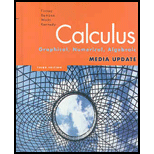
Concept explainers
(a)
To explain:The convincing argument that
(a)
Answer to Problem 51E
By the definition of one-to-one function, the function
Explanation of Solution
Given information:The function is
It is known that a function is one-to-one on its domain if
For any
As it is known that
Therefore, by the definition of one-to-one function, the function
(b)
To find:The formula for the inverse of
(b)
Answer to Problem 51E
The inverse of
Explanation of Solution
Given information:The function is
Calculation:
Interchange the
Substitute
As the slope of
Therefore, the inverse of
(c)
To write:The conclusion about the graphs of the inverse of the functions if the graph of two functions are parallel line with non-zero slope.
(c)
Answer to Problem 51E
The graphs of the inverse will be parallel lines with non-zero slope.
Explanation of Solution
Given information:It is given that the graphs of two functions are parallel lines with non-zero slope.
If the original functions hasslope
Therefore, the graphs of the inverse will be parallel lines with non-zero slope.
(d)
To write:The conclusion about the graphs of the inverse of the functions.
(d)
Answer to Problem 51E
The graphs of the inverse will be perpendicular lines with non-zero slope.
Explanation of Solution
Given information:It is given that the graphs of two functions are perpendicular lines with non-zero slope.
The lines are perpendicular so the original function will have the slopes
Since each of
Therefore, the graphs of the inverse will be perpendicular lines with non-zero slope.
Chapter 1 Solutions
Calculus: Graphical, Numerical, Algebraic
Additional Math Textbook Solutions
Thinking Mathematically (6th Edition)
Elementary Statistics
Elementary Statistics (13th Edition)
A First Course in Probability (10th Edition)
Calculus: Early Transcendentals (2nd Edition)
A Problem Solving Approach To Mathematics For Elementary School Teachers (13th Edition)
- explain of logical relationships of (11.1.1), (11.1.2), (11.3.4), (11.3.6)arrow_forwardProve 11.1.2arrow_forward39. (a) Show that Σeak converges for each α > 0. (b) Show that keak converges for each a > 0. k=0 (c) Show that, more generally, Σk"eak converges for each k=0 nonnegative integer n and each a > 0.arrow_forward
- #3 Find the derivative y' = of the following functions, using the derivative rules: dx a) y-Cos 6x b) y=x-Sin4x c) y=x-Cos3x d) y=x-R CD-X:-:TCH :D:D:D - Sin f) Sin(x²) (9) Tan (x³)arrow_forwardmate hat is the largest area that can be en 18 For the function y=x³-3x² - 1, use derivatives to: (a) determine the intervals of increase and decrease. (b) determine the local (relative) maxima and minima. (c) determine the intervals of concavity. (d) determine the points of inflection. b) (e) sketch the graph with the above information indicated on the graph.arrow_forwarduse L'Hopital Rule to evaluate the following. a) 4x3 +10x2 23009׳-9 943-9 b) hm 3-84 хто бу+2 < xan x-30650)arrow_forward
 Calculus: Early TranscendentalsCalculusISBN:9781285741550Author:James StewartPublisher:Cengage Learning
Calculus: Early TranscendentalsCalculusISBN:9781285741550Author:James StewartPublisher:Cengage Learning Thomas' Calculus (14th Edition)CalculusISBN:9780134438986Author:Joel R. Hass, Christopher E. Heil, Maurice D. WeirPublisher:PEARSON
Thomas' Calculus (14th Edition)CalculusISBN:9780134438986Author:Joel R. Hass, Christopher E. Heil, Maurice D. WeirPublisher:PEARSON Calculus: Early Transcendentals (3rd Edition)CalculusISBN:9780134763644Author:William L. Briggs, Lyle Cochran, Bernard Gillett, Eric SchulzPublisher:PEARSON
Calculus: Early Transcendentals (3rd Edition)CalculusISBN:9780134763644Author:William L. Briggs, Lyle Cochran, Bernard Gillett, Eric SchulzPublisher:PEARSON Calculus: Early TranscendentalsCalculusISBN:9781319050740Author:Jon Rogawski, Colin Adams, Robert FranzosaPublisher:W. H. Freeman
Calculus: Early TranscendentalsCalculusISBN:9781319050740Author:Jon Rogawski, Colin Adams, Robert FranzosaPublisher:W. H. Freeman
 Calculus: Early Transcendental FunctionsCalculusISBN:9781337552516Author:Ron Larson, Bruce H. EdwardsPublisher:Cengage Learning
Calculus: Early Transcendental FunctionsCalculusISBN:9781337552516Author:Ron Larson, Bruce H. EdwardsPublisher:Cengage Learning





